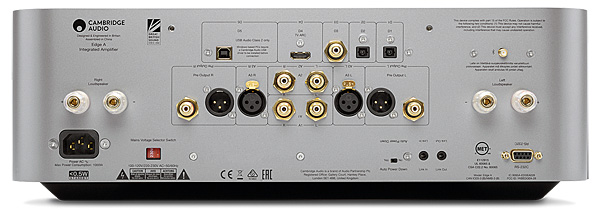Cambridge Audio Edge A integrated amplifier

 Named after Cambridge Audio’s founding father, this new integrated amplifier includes a DSD-compatible DAC and Bluetooth aptX HD. But does it really have an Edge...?
Named after Cambridge Audio’s founding father, this new integrated amplifier includes a DSD-compatible DAC and Bluetooth aptX HD. But does it really have an Edge...?
There’s one very noticeable thing about the new Edge range from Cambridge Audio – well, apart from the fact that these hefty new high-end components are quite a long way from the company’s usual entry/midrange territory, that is. Look at any of the new products and you’ll notice the branding – it simply says ‘Cambridge’, as if to set this range apart, and fit in with the minimalist-but-purposeful vibe of the whole lineup.
Launched as part of the company’s 50th anniversary celebrations, the Edge range is named in honour of one of its founders, Professor Gordon Edge, who died five years ago. He was responsible for the first Cambridge Audio product, the P40 amplifier of 1968, not to mention the development of the ‘technology cluster’ based around Cambridge University, from which Cambridge Audio sprang.
‘Edge’ takes the brand into what is – at least in the modern era – uncharted territory for Cambridge Audio. The range comprises the £4500 Edge A integrated amplifier, the £3500 Edge NQ network player/preamp, and the £2500 Edge W, claimed to be the best power amp the company has ever made which, like the Edge A, is rated at 100W per channel.
Inspirational Design
The designs are all-new, though PM’s boxout [see Sidebar] suggests that not all Cambridge’s legacy innovation has been removed from the tool box. At first glance it must be said that the look and build of the range is every bit the equal of other components in the high-end arena into which Cambridge is launching itself, including many products costing much more than the Edge lineup. The curvaceous front panels and immaculate finish instantly inspire confidence, and if the image the brand summons up in your mind is the budget aesthetic of bargain amps of the past, it’s certainly time to think again. Mind you, by the time you’ve hauled all 24.4kg of the Edge A from its beautifully considered packaging, chances are you’ll have realised that!

The result of a team of nine engineers working full-time for three years, the Edge range is certainly ambitious, and the company makes great play of the fact its brief was one of no limitations in cost or engineering. It simply wanted these new products to be the best it could make. And before you say ‘Yes, but how will all that play on the shelves of Richer Sounds?’, bear a couple of things in mind. First, that retailer, the sole source of Cambridge products in the UK, has come a long way from its roots as a place to buy ultra-cheap recently discontinued products and the like; and second, around the world the Cambridge Audio brand stands on its own feet, and consistently does rather well.
Complex Simplicity
The first question most are likely to ask when faced with the Edge A, looking at that simple fascia with its single control, is ‘How does that work, then?’. Welcome to Cambridge’s concept of ‘complex simplicity’, for that knob is actually a volume control with a concentric knurled ring for input selection. This accesses the amp’s three analogue ins (one on balanced XLRs, two on RCAs), five digital connections (USB Type B for computer input, two optical and one coaxial, and even an HDMI with Audio Return Channel for TV sound), and Bluetooth HD.
Rather in the manner of the Hegel H590 [HFN Oct ’18] this is a high-performance amplifier designed for real-world use, and for all its minimal looks, this isn’t a limited, tweaky device. It’s about as hard to set up and use as the average £300 mini system, but sounds much, much better. Aiding that ease of use is a remote handset that’s almost as minimal-looking as the amp itself [see Lab Report] – although it does have track-skip buttons to control a player as well as volume up/down, mute and source selection. However, a row of four programmable buttons below the main ‘wheel’ of controls on the handset is rather clever – press and hold one of them and you store both the currently selected input and its volume level.
As well as the convenience of selecting inputs once these buttons are set up, you can of course use this functionality to set one of the analogue ins to suit working with the front left/right pre outs of an AV receiver or processor, thus enabling the amp to be integrated into a home cinema system if required. The Edge A will drive a single set of speakers, but also has pre outs to feed an external power amp, on both XLRs and phonos. PM noted an anomaly when they are used without speakers connected, however. In practice it’s not possible to turn off the internal power amplification, so the amp will still clip and shut down if the protection is triggered due to the preamp volume being advanced too far…

























































